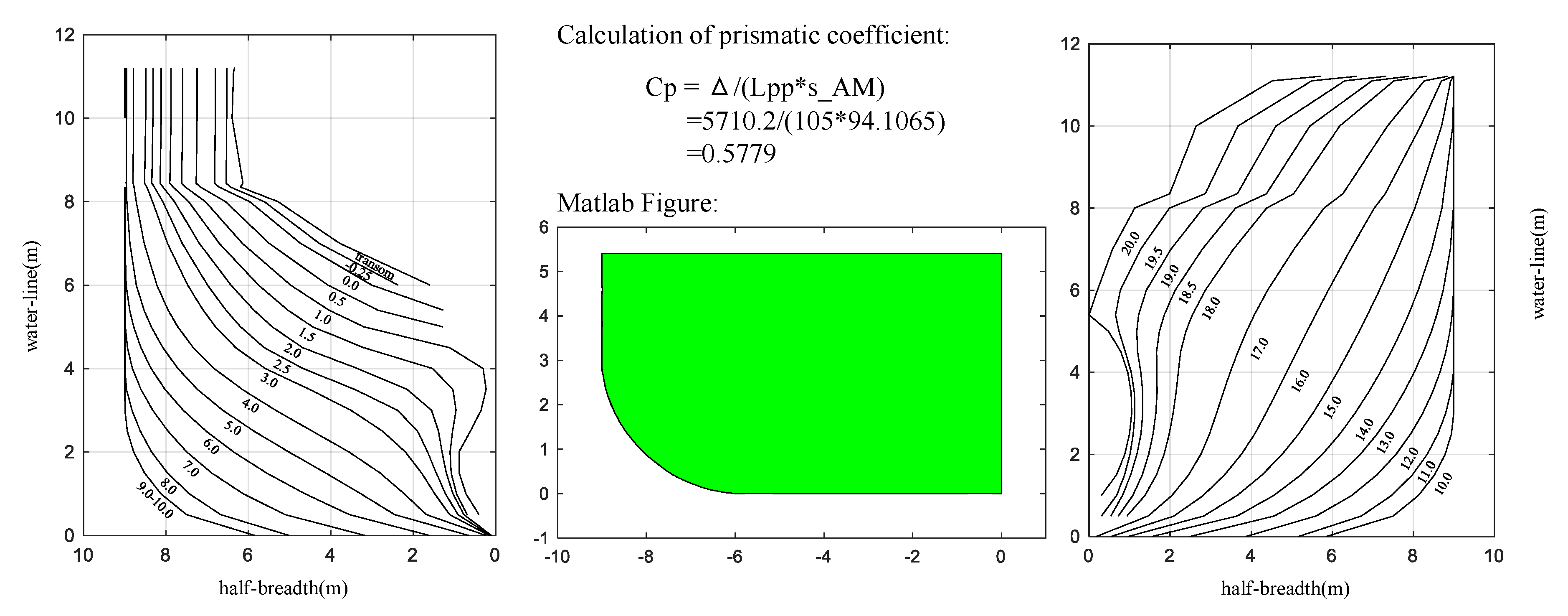Full-Scale Maneuvering Trials Correction and Motion Modelling Based on Actual Sea and Weather Conditions
Abstract
1. Introduction
2. Traditional Correction Method
3. Improved Correction Method
3.1. Wind Load Calculation
3.2. Wave Drift Force Calculation
3.3. Resultant Distance Induced by Wind, Wave and Current
4. Maneuver Modeling Method
4.1. RM-SVM Model
4.2. Whole Ship Model
5. The Case of Trial Correction
5.1. General Details of Sea Trial
5.2. Wind Load and Wave Drift Force Results
5.3. Wind- and Wave-Induced Acceleration Results
5.4. Wind- and Wave-Induced Distance Results
5.5. Track and Velocity Correction Results
6. The Case of Maneuver Modeling
6.1. +20° Turning Circle Test
6.2. The Ship Hydrodynamic Coefficient Result and −35° Turning Circle Validation
7. Discussion
8. Conclusions
- (1)
- Due to the sea trial track and velocity being difficult to use for modeling directly, based on the assumption of the full developed wind and wave, an improved sea trial correction method was proposed. In this method, the wind, wave and current drift influences were calculated separately, and the adjusting parameters for the optical drift distances were solved by pattern search algorithm. The corrected track and velocity vectors were applied to modify the original data. The correction results of all trials illustrated the effectiveness of the proposed method.
- (2)
- According to the prediction example of the Yukun +20° turning circle test, it can be concluded that the maneuver model was precise. On the basis of the estimation results, the ship hydrodynamic coefficients in whole ship model were identifiable. From the track prediction of a −35° turning circle, the Yukun satisfies the IMO standard for ship maneuverability. In addition, the accuracy of the advance and tactical diameter reached 93% and 95%.
- (3)
- It will be much more convincing to validate this manuscript in several ships. However, it is not easy to obtain sea trials, as only the Yukun motor vessel test was organized and collected. In the future, there will be a new motor vessel built for maritime autonomous surface ship (MASS) research at Dalian Maritime University. The public building project has been approved. The correction and modeling of the new MASS will appear soon, once the trials are carried out.
- (4)
- Nowadays, ship maneuvering in waves is a tough and hot issue for the researcher as presented by ITTC 2017. Full-scale maneuvering in waves, including the rolling, heaving and pitch of ships, will be included in future works as soon as possible.
Author Contributions
Funding
Acknowledgments
Conflicts of Interest
Appendix A
Appendix B


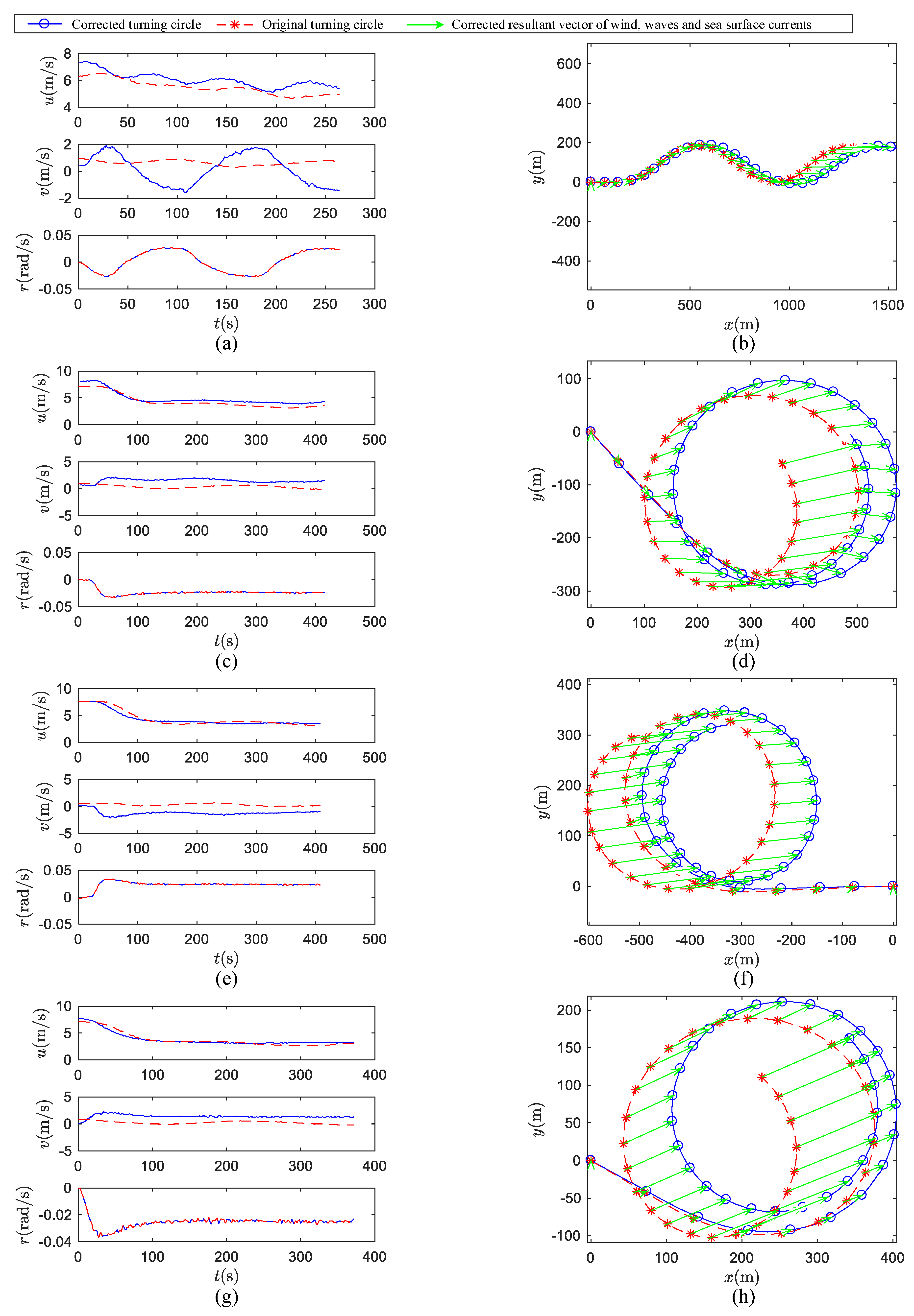
References
- Lee, H.W.; Roh, M.I. Review of the multibody dynamics in the applications of ships and offshore structures. Ocean Eng. 2018, 167, 65–76. [Google Scholar] [CrossRef]
- Abkowitz, M.A. Measurement of hydrodynamic characteristics from ship maneuvering trials by system identification. Trans. SNAME 1980, 88, 283–318. [Google Scholar]
- Zhang, G.; Zhang, X.; Pang, H. Multi-innovation auto-constructed least squares identification for 4 DOF ship maneuvering modelling with full-scale trial data. ISA Trans. 2015, 56, 75–85. [Google Scholar] [CrossRef] [PubMed]
- Bai, W.W.; Ren, J.S.; Li, T.S. Multi-innovation gradient iterative locally weighted learning identification for a nonlinear ship maneuvering system. China Ocean Eng. 2018, 32, 288–300. [Google Scholar] [CrossRef]
- Kim, D.W.; Knud, B.; Mathias, P. Estimation of hydrodynamic coefficients from sea trials using a system identification method. J. Korean Soc. Mar. Environ. Saf. 2017, 23, 258–265. [Google Scholar] [CrossRef]
- Maritime Safety Committee. The standards for ship maneuverability MSC 137(76). Available online: http://www.imo.org/en/KnowledgeCentre/IndexofIMOResolutions/Maritime-Safety-Committee-%28MSC%29/Documents/MSC.137%2876%29.pdf (accessed on 13 July 2020).
- Society of Naval Architects and Marine Engineers (SNAME). Guide for Sea Trials (Progressive Speed, Maneuvering and Endurance) Technical and Research Bulletin; SNAME: Alexandria, VA, USA, 2015; pp. 3–47. [Google Scholar]
- International Towing Tank Conference (ITTC). Recommended Procedures and Guidelines-Full Scale Maneuvering Trials; ITTC: Universitätsstrasse, Zürich, Switzerland, 2017; pp. 14–15. [Google Scholar]
- Bishop, R.C.; Belknap, W.; Turner, C. Parametric Investigation on the Influence of GM Roll Damping and Above-Water Form on the Roll Response of Model 5613; Naval Surface Warfare Center: West Bethesda, MD, USA, 2005; pp. 11–17. [Google Scholar]
- National Maritime Research Institute (NMRI). Development of an Innovative Tank Model Test Methodology for Measuring Actual Sea Performance of Ships; NMRI: Tokyo, Japan, 2016; pp. 13–21.
- National Maritime Research Institute (NMRI). Research on the Development of Energy Saving Device in Actual Sea; NMRI: Tokyo, Japan, 2017; pp. 79–84.
- Isherwood, R.M. Wind resistance on merchant ships. Trans. RINA 1973, 115, 327–338. [Google Scholar]
- Blendermann, W. Parameter identification of wind loads on ships. J. Wind Eng. Ind. Aerod. 1994, 51, 339–351. [Google Scholar] [CrossRef]
- Fujiwara, T.; Ueno, M.; Nimura, T. Estimation of wind forces and moments acting on ships. J. Soc. Nav. Archit. Jpn. 1988, 183, 77–90. [Google Scholar] [CrossRef]
- Andersen, V.I.M. Wind loads on post-panamax container ship. Ocean Eng. 2013, 58, 115–134. [Google Scholar] [CrossRef]
- Motora, S. On the measurement of added mass and added moment of inertia for ship motions. J. Zosen Kiokai 1959, 105, 83–92. [Google Scholar] [CrossRef]
- Zhou, Z.M.; Sheng, Z.Y.; Fen, W.S. On maneuverability prediction for multipurpose cargo ship. Ship Eng. 1983, 6, 21–36. [Google Scholar]
- Daidola, J.C.; Graham, D.A.; Chandrash, L. A simulation program for vessel’s maneuvering at slow speeds. In Proceedings of the 11th Ship Technology and Research Symposium, Portland, OR, USA, 21–23 May 1986; pp. 156–161. [Google Scholar]
- Li, Z.; Sun, J.; Beck, R.F. Evaluation and modification of a robust path following controller for marine surface vessels in wave fields. J. Ship Res. 2010, 54, 141–147. [Google Scholar]
- Yasukawa, H. Simulations of ship maneuvering in waves 1st report turning motion. J. Soc. Nav. Archit. Jpn. 2006, 4, 127–136. [Google Scholar] [CrossRef][Green Version]
- Zhang, W.; Zou, Z.J. Time domain simulations of the wave induced motions of ships in maneuvering condition. J. Mar. Sci. Technol. Jpn. 2016, 21, 154–166. [Google Scholar] [CrossRef]
- Hong, L.; Zhu, R.C.; Miao, G.P.; Fan, J.; Li, S. An investigation into added resistance of vessels advancing in waves. Ocean Eng. 2016, 123, 238–248. [Google Scholar] [CrossRef]
- Mei, B.; Sun, L.; Shi, G. Ship maneuvering prediction based on grey-box model identification via adaptive RM-SVM with small rudder angle. Pol. Marit. Res. 2019, 26, 115–127. [Google Scholar] [CrossRef]
- Yabuki, H.; Yoshimura, Y.; Ishiguro, T.; Ueno, M. Turning Motion of a Ship with Single CPP and Single Rudder during Stopping Maneuver under Windy Condition; International Conference on Ship Manoeuvrability and Maritime Simulation: Terschelling, The Netherlands, 2006; pp. 4–5. [Google Scholar]
- Kasa, I. A curve fitting procedure and its error analysis. IEEE Trans. Instrum. Meas. 1976, 25, 8–14. [Google Scholar] [CrossRef]
- Bakdi, A.; Glad, I.K.; Vanem, E.; Engelhardtsen, Ø. AIS-based multiple vessel collision and grounding risk identification based on adaptive safety domain. J. Mar. Sci. Eng. 2020, 8, 5. [Google Scholar] [CrossRef]
- Niu, J.; Liang, X.; Zhang, X. Time-Varying Kelvin Wake Model and Microwave Velocity Observation. Sensors 2020, 20, 1575. [Google Scholar] [CrossRef]
- Sung, Y.J.; Park, S.H.; Ahn, K.S. Evaluation on deep water maneuvering performances of KVLCC2 based on PMM test and RANS simulation. In SIMMAN 2014; FORCE Technology: Lyngby, Denmark, 2014; pp. 1–6. [Google Scholar]
- Shan, X.F. Probing the Cyclicity of “YUKUN” under the Influence of Wind and Current. Masters’ Thesis, Dalian Maritime University, Dalian, China, 2013. [Google Scholar]
- Su, Z.J. The Numerical Simulation and Analysis of Parametric Rolling for Vessel “YUKUN”. Masters’ Thesis, Dalian Maritime University, Dalian, China, 2011. [Google Scholar]
- Jiang, Y.; Zheng, K. The Single-Shore-Station-Based position estimation method of an Automatic Identification System. Sensors 2020, 20, 1590. [Google Scholar] [CrossRef]
- Kim, D.; Lee, S.; Lee, J. Data-driven prediction of vessel propulsion power using support vector regression with onboard measurement and ocean data. Sensors 2020, 20, 1588. [Google Scholar] [CrossRef] [PubMed]
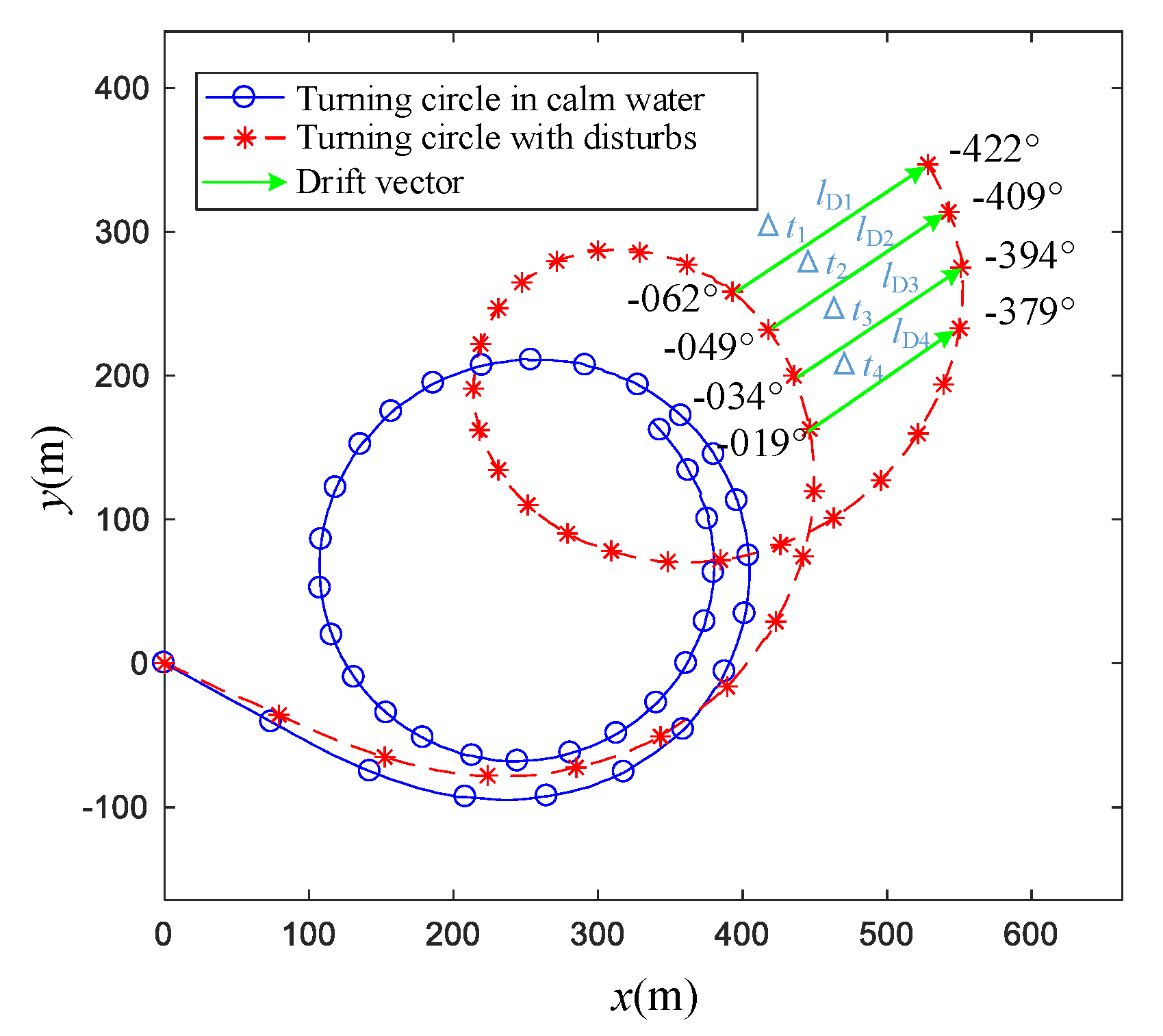
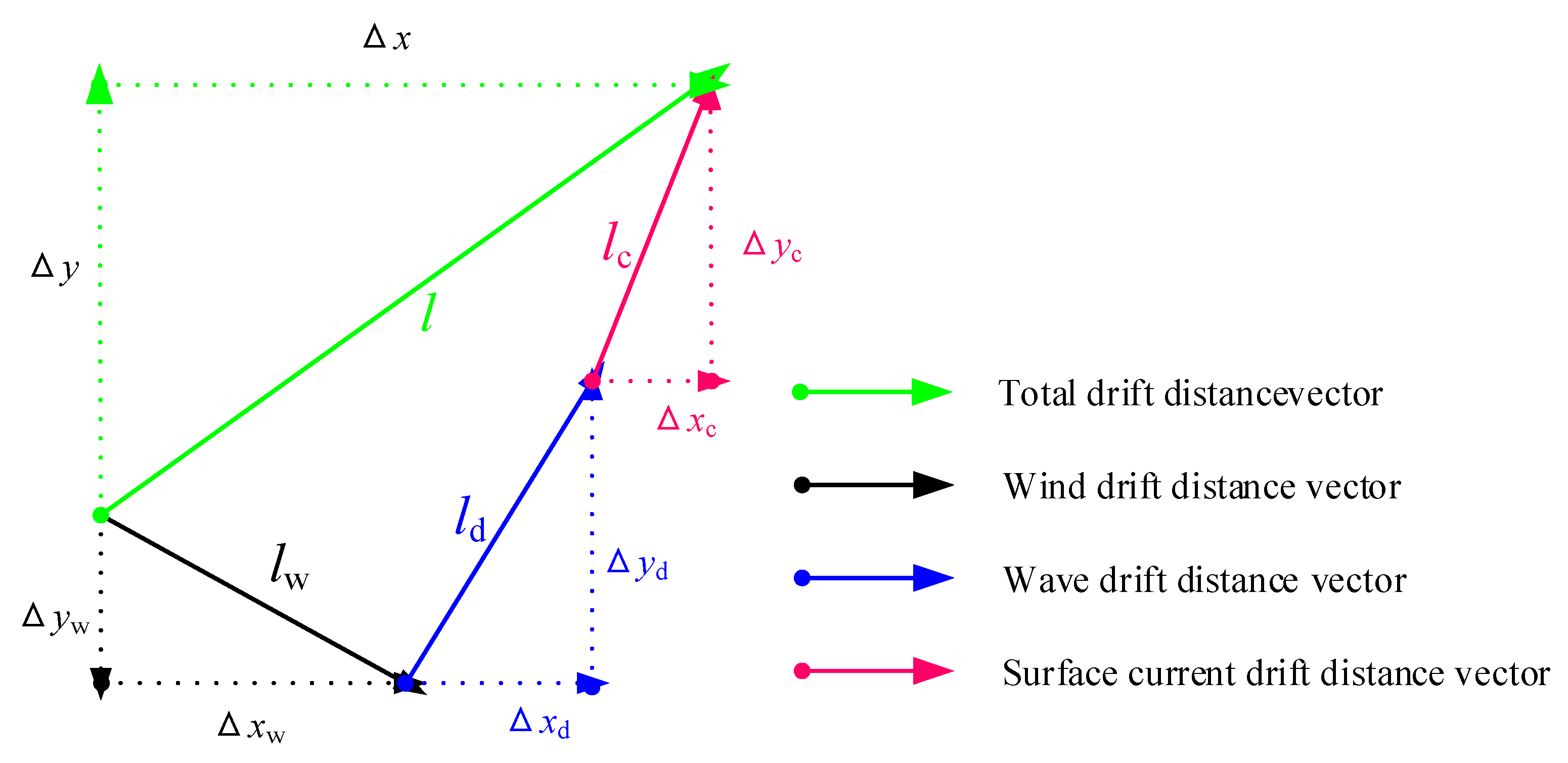
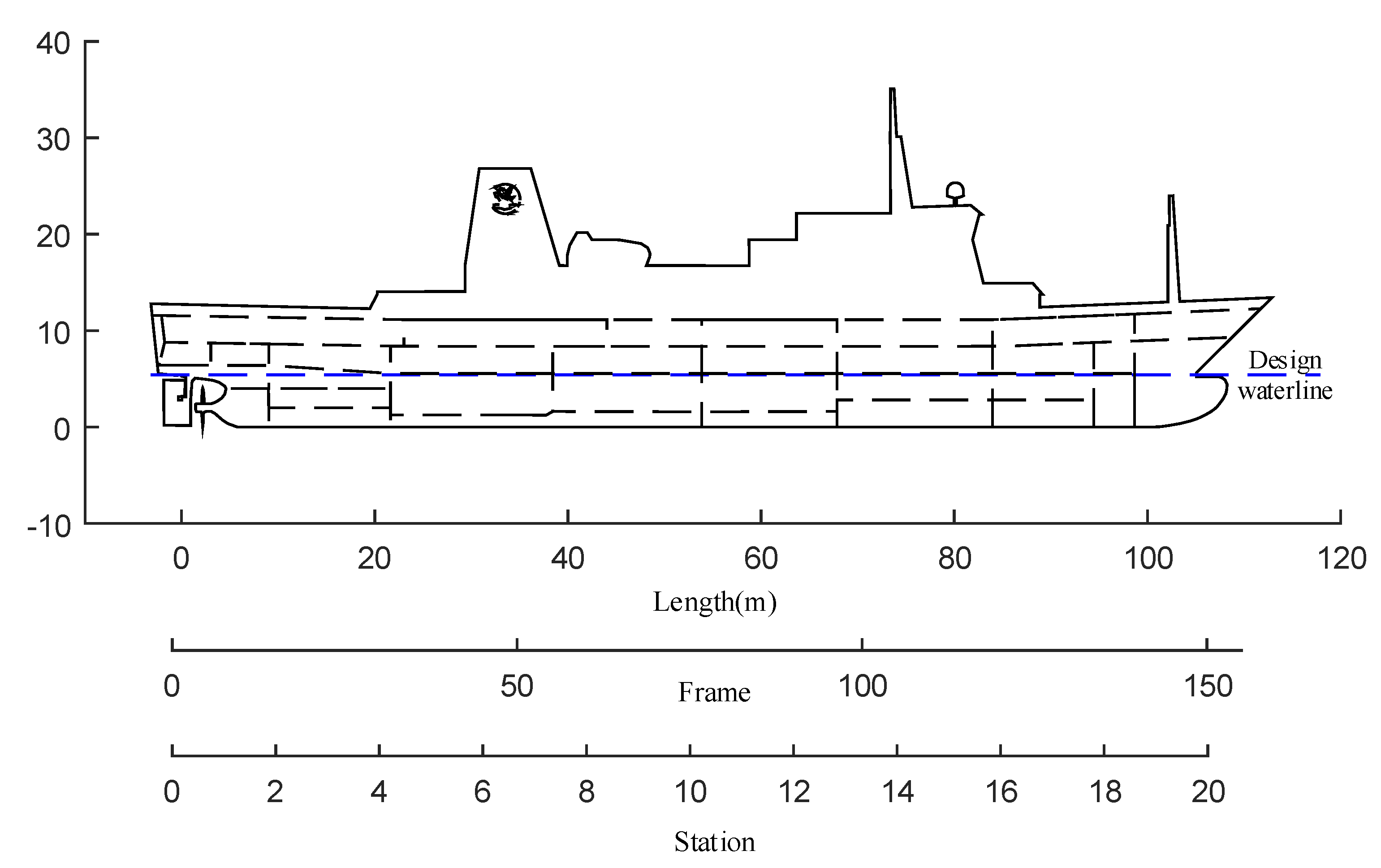


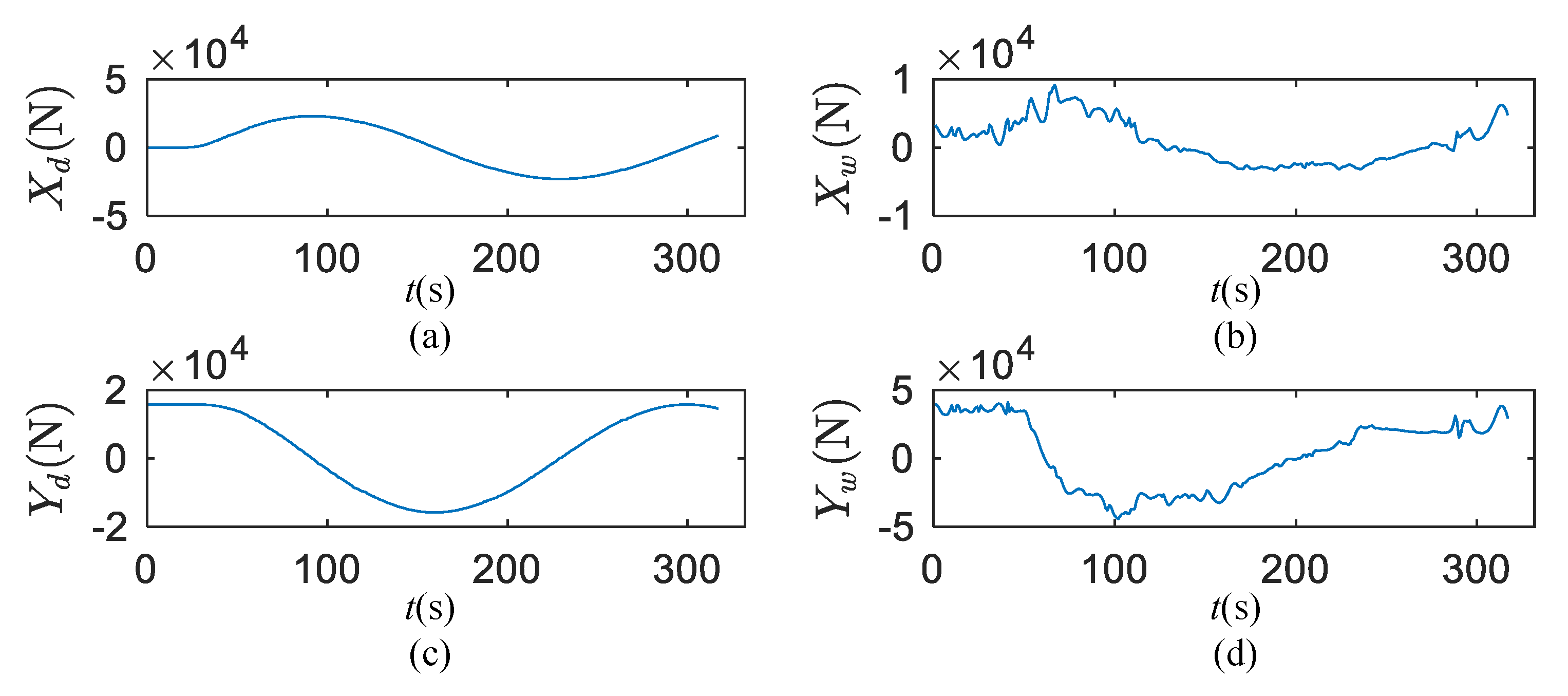


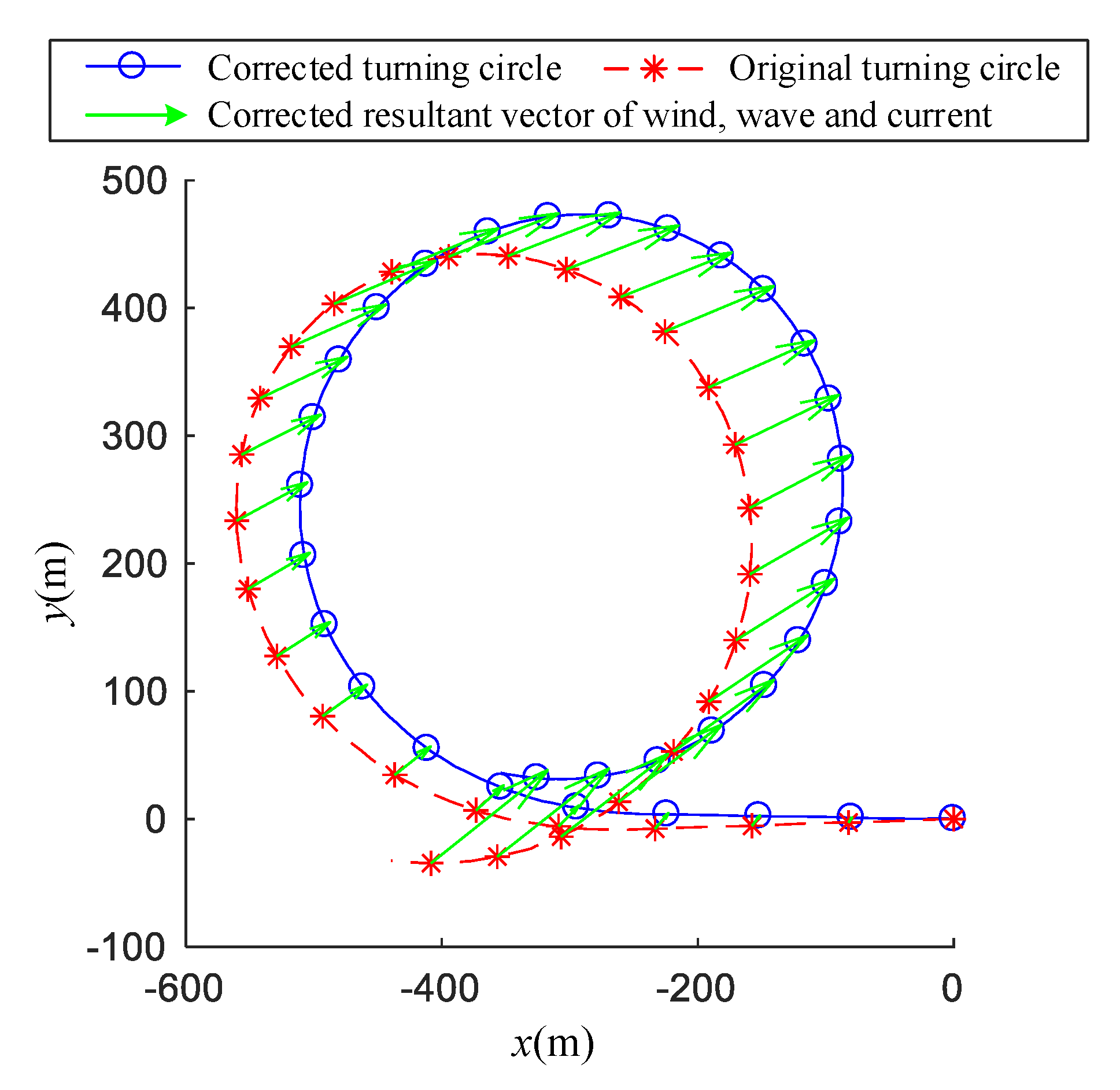
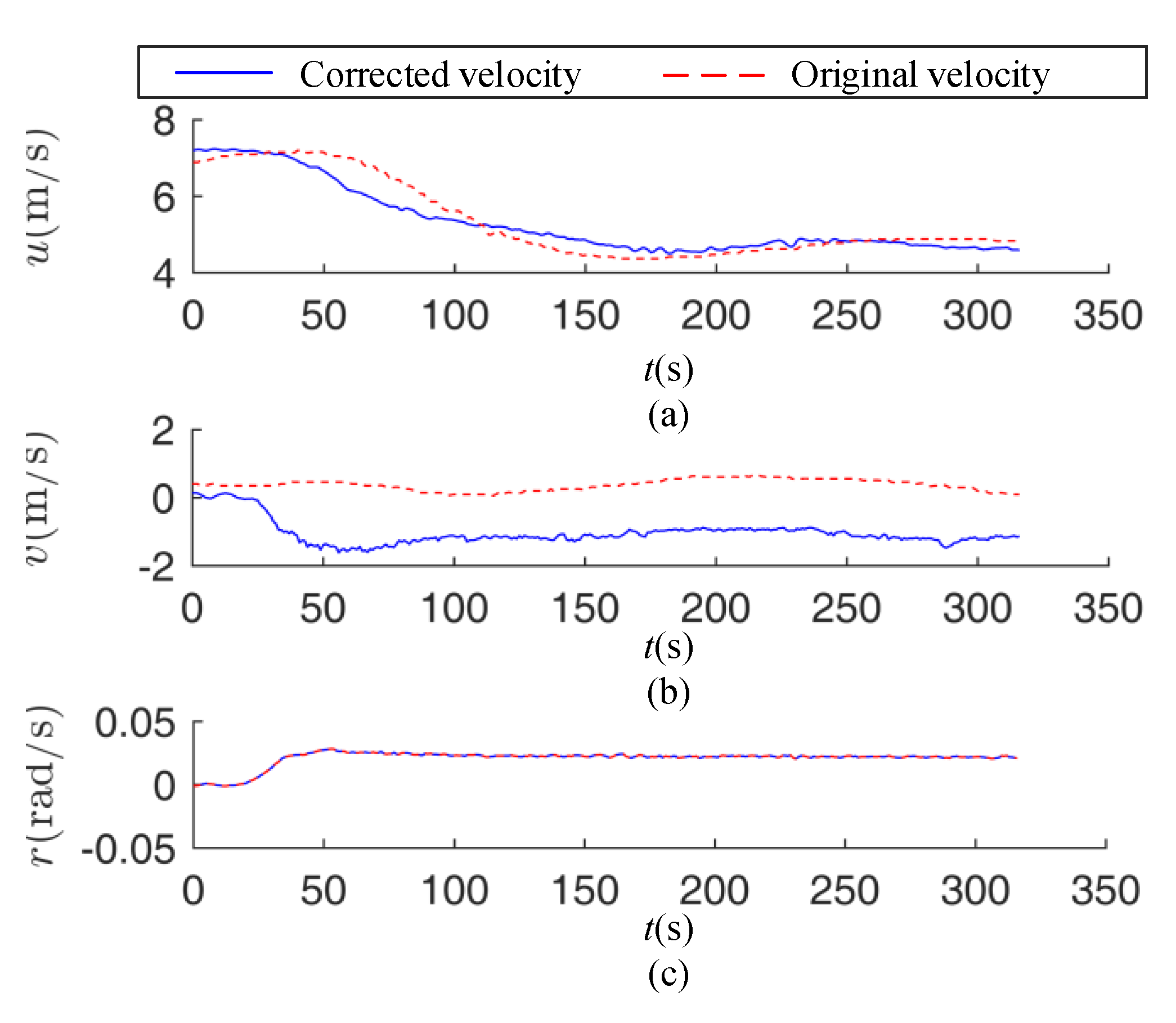

| Particulars | Values | Particulars | Values |
|---|---|---|---|
| Displacement | 5710.2 | Rudder area | 11.8 m2 |
| Length overall | 116 m | Rudder height | 4.8 m |
| Length between perpendiculars | 105 m | Propeller diameter | 3.8 m |
| Designed waterline length | 106.5 m | Blade number | 4 |
| Ship breadth | 18 m | Blade area ratio | 0.67 |
| Full-load draft | 5.4 m | Maximum rudder rate | 2.8°/s |
| Block coefficient | 0.56 | Prismatic coefficient | 0.58 |
| NO. | Time Points (s) | Maneuvers Type | Rudder Angle (°) | Sample Points |
|---|---|---|---|---|
| 1 | 38213–38769 | Turning circle | 5 | 556 |
| 2 | 39232–39635 | Turning circle | 10 | 403 |
| 3 | 39898–40231 | Turning circle | 15 | 333 |
| 4 | 40619–40915 | Turning circle | 20 | 296 |
| 5 | 44577–44985 | Turning circle | 25 | 408 |
| 6 | 45509–45946 | zigzag | 10/−10 | 437 |
| 7 | 45975–46542 | zigzag | 20/−20 | 567 |
| 8 | 46606–46910 | zigzag | 10/−10 | 304 |
| 9 | 46999–47263 | zigzag | 20/−20 | 264 |
| 10 | 47517–47912 | Turning circle | 25 | 395 |
| 11 | 48178–48566 | Turning circle | −30 | 388 |
| 12 | 49070–49450 | Turning circle | 34 | 380 |
| −130.4 | −69.1 | −3.8 | |||
| 1079.1 | −124.0 | ||||
| −808.7 | 104.3 | ||||
| 630.3 | 622.3 | 38.4 | |||
| −1637.8 | −1397.1 | −80.0 | |||
| 3135.2 | −1711.9 | 194.2 | |||
| −981.7 | 5978.4 | −670.6 | |||
| −1159.0 | 283.8 | −59.9 | |||
| 0.0 | −12,927.7 | 3647.3 | |||
| 59.5 | 249.2 | −53.8 | |||
| −4829.9 | 418.3 | ||||
| 419.2 | −23,264.0 | 2774.4 | |||
| −23,891.8 | 4561.3 | ||||
| Method | Advance | Tactical Diameter | |
|---|---|---|---|
| IMO standard for ship maneuverability | 4.5LPP | 5LPP | |
| Sea trial result | Value | 3.21LPP | 2.98LPP |
| Percentage | 71% | 60% | |
| Prediction by RM-SVM in this paper | Value | 2.99LPP | 3.08LPP |
| Percentage | 66% | 62% | |
| Prediction accuracy | 93% | 97% | |
© 2020 by the authors. Licensee MDPI, Basel, Switzerland. This article is an open access article distributed under the terms and conditions of the Creative Commons Attribution (CC BY) license (http://creativecommons.org/licenses/by/4.0/).
Share and Cite
Mei, B.; Sun, L.; Shi, G. Full-Scale Maneuvering Trials Correction and Motion Modelling Based on Actual Sea and Weather Conditions. Sensors 2020, 20, 3963. https://doi.org/10.3390/s20143963
Mei B, Sun L, Shi G. Full-Scale Maneuvering Trials Correction and Motion Modelling Based on Actual Sea and Weather Conditions. Sensors. 2020; 20(14):3963. https://doi.org/10.3390/s20143963
Chicago/Turabian StyleMei, Bin, Licheng Sun, and Guoyou Shi. 2020. "Full-Scale Maneuvering Trials Correction and Motion Modelling Based on Actual Sea and Weather Conditions" Sensors 20, no. 14: 3963. https://doi.org/10.3390/s20143963
APA StyleMei, B., Sun, L., & Shi, G. (2020). Full-Scale Maneuvering Trials Correction and Motion Modelling Based on Actual Sea and Weather Conditions. Sensors, 20(14), 3963. https://doi.org/10.3390/s20143963



